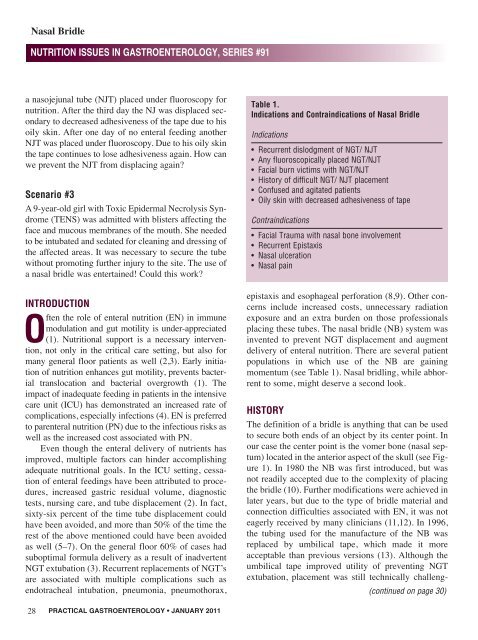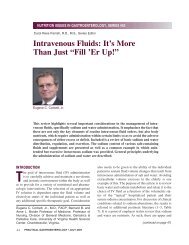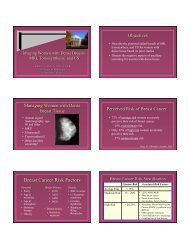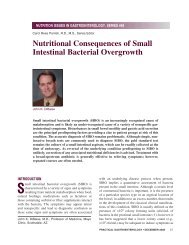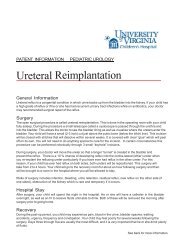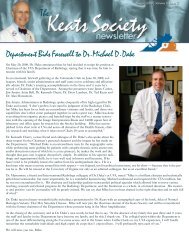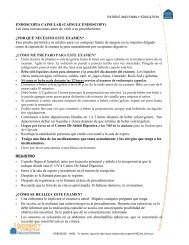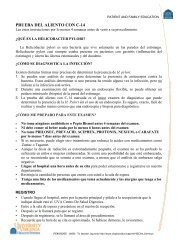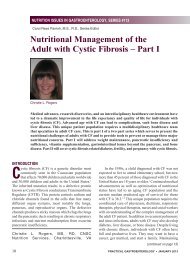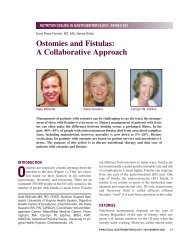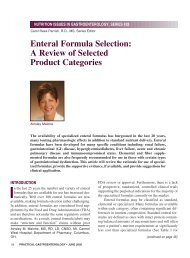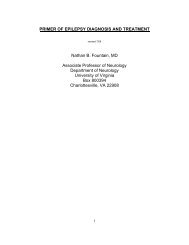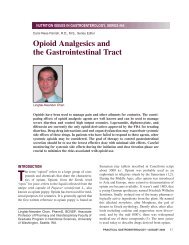Nasal Bridle: Married to Your Tube - Medicine - University of Virginia
Nasal Bridle: Married to Your Tube - Medicine - University of Virginia
Nasal Bridle: Married to Your Tube - Medicine - University of Virginia
Create successful ePaper yourself
Turn your PDF publications into a flip-book with our unique Google optimized e-Paper software.
<strong>Nasal</strong> <strong>Bridle</strong><br />
NUTRITION ISSUES IN GASTROENTEROLOGY, SERIES #91<br />
a nasojejunal tube (NJT) placed under fluoroscopy for<br />
nutrition. After the third day the NJ was displaced secondary<br />
<strong>to</strong> decreased adhesiveness <strong>of</strong> the tape due <strong>to</strong> his<br />
oily skin. After one day <strong>of</strong> no enteral feeding another<br />
NJT was placed under fluoroscopy. Due <strong>to</strong> his oily skin<br />
the tape continues <strong>to</strong> lose adhesiveness again. How can<br />
we prevent the NJT from displacing again?<br />
Scenario #3<br />
A 9-year-old girl with Toxic Epidermal Necrolysis Syndrome<br />
(TENS) was admitted with blisters affecting the<br />
face and mucous membranes <strong>of</strong> the mouth. She needed<br />
<strong>to</strong> be intubated and sedated for cleaning and dressing <strong>of</strong><br />
the affected areas. It was necessary <strong>to</strong> secure the tube<br />
without promoting further injury <strong>to</strong> the site. The use <strong>of</strong><br />
a nasal bridle was entertained! Could this work?<br />
INTRODUCTION<br />
Often the role <strong>of</strong> enteral nutrition (EN) in immune<br />
modulation and gut motility is under-appreciated<br />
(1). Nutritional support is a necessary intervention,<br />
not only in the critical care setting, but also for<br />
many general floor patients as well (2,3). Early initiation<br />
<strong>of</strong> nutrition enhances gut motility, prevents bacterial<br />
translocation and bacterial overgrowth (1). The<br />
impact <strong>of</strong> inadequate feeding in patients in the intensive<br />
care unit (ICU) has demonstrated an increased rate <strong>of</strong><br />
complications, especially infections (4). EN is preferred<br />
<strong>to</strong> parenteral nutrition (PN) due <strong>to</strong> the infectious risks as<br />
well as the increased cost associated with PN.<br />
Even though the enteral delivery <strong>of</strong> nutrients has<br />
improved, multiple fac<strong>to</strong>rs can hinder accomplishing<br />
adequate nutritional goals. In the ICU setting, cessation<br />
<strong>of</strong> enteral feedings have been attributed <strong>to</strong> procedures,<br />
increased gastric residual volume, diagnostic<br />
tests, nursing care, and tube displacement (2). In fact,<br />
sixty-six percent <strong>of</strong> the time tube displacement could<br />
have been avoided, and more than 50% <strong>of</strong> the time the<br />
rest <strong>of</strong> the above mentioned could have been avoided<br />
as well (5–7). On the general floor 60% <strong>of</strong> cases had<br />
suboptimal formula delivery as a result <strong>of</strong> inadvertent<br />
NGT extubation (3). Recurrent replacements <strong>of</strong> NGT’s<br />
are associated with multiple complications such as<br />
endotracheal intubation, pneumonia, pneumothorax,<br />
28<br />
PRACTICAL GASTROENTEROLOGY JANUARY 2011<br />
Table 1.<br />
Indications and Contraindications <strong>of</strong> <strong>Nasal</strong> <strong>Bridle</strong><br />
Indications<br />
Recurrent dislodgment <strong>of</strong> NGT/ NJT<br />
Any fluoroscopically placed NGT/NJT<br />
Facial burn victims with NGT/NJT<br />
His<strong>to</strong>ry <strong>of</strong> difficult NGT/ NJT placement<br />
Confused and agitated patients<br />
Oily skin with decreased adhesiveness <strong>of</strong> tape<br />
Contraindications<br />
Facial Trauma with nasal bone involvement<br />
Recurrent Epistaxis<br />
<strong>Nasal</strong> ulceration<br />
<strong>Nasal</strong> pain<br />
epistaxis and esophageal perforation (8,9). Other concerns<br />
include increased costs, unnecessary radiation<br />
exposure and an extra burden on those pr<strong>of</strong>essionals<br />
placing these tubes. The nasal bridle (NB) system was<br />
invented <strong>to</strong> prevent NGT displacement and augment<br />
delivery <strong>of</strong> enteral nutrition. There are several patient<br />
populations in which use <strong>of</strong> the NB are gaining<br />
momentum (see Table 1). <strong>Nasal</strong> bridling, while abhorrent<br />
<strong>to</strong> some, might deserve a second look.<br />
HISTORY<br />
The definition <strong>of</strong> a bridle is anything that can be used<br />
<strong>to</strong> secure both ends <strong>of</strong> an object by its center point. In<br />
our case the center point is the vomer bone (nasal septum)<br />
located in the anterior aspect <strong>of</strong> the skull (see Figure<br />
1). In 1980 the NB was first introduced, but was<br />
not readily accepted due <strong>to</strong> the complexity <strong>of</strong> placing<br />
the bridle (10). Further modifications were achieved in<br />
later years, but due <strong>to</strong> the type <strong>of</strong> bridle material and<br />
connection difficulties associated with EN, it was not<br />
eagerly received by many clinicians (11,12). In 1996,<br />
the tubing used for the manufacture <strong>of</strong> the NB was<br />
replaced by umbilical tape, which made it more<br />
acceptable than previous versions (13). Although the<br />
umbilical tape improved utility <strong>of</strong> preventing NGT<br />
extubation, placement was still technically challeng-<br />
(continued on page 30)


